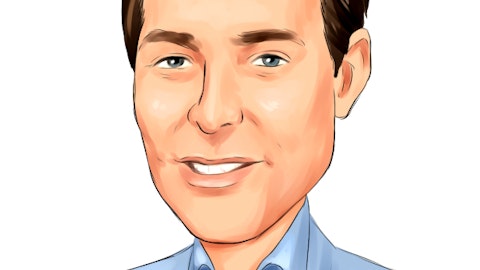Chris Blunt: Sure. I’ll maybe drop some breadcrumbs and Wendy could provide probably maybe a little more specifics around that. But yes, I think the top line environment is fantastic. So you saw this past year, we did $13 billion of gross sales. I want to say, $9-and-change billion in net sales. So obviously, the capital infusion from FNF is helpful. So we’ve said publicly, we still think we can continue to grow top line at a healthy double-digit pace. We’ve obviously done better than that in years past. I think now we can retain a higher level given what’s there. I think if you look at our traditional growth in net sales, my guess is that’s still a pretty decent barometer for what we can add despite the fact that we’ve doubled the assets in the last three years.
So yes, we feel really good about it. There’s been a lot of hoopla about, well, surrenders are up, but inflows are way up. And so I know it sounds odd, but unlike a bank, someone surrendering a very old contract with a small surrender charge, but then bringing in a brand-new contract with a brand-new surrender charge. Ironically, we’re actually improving the risk profile of our liabilities. And generally, we’re booking a profit when someone’s paying a surrender charge. So it’s an unusual scenario. Yes, surrenders are up a little bit, but I don’t think it changes materially kind of our pattern of net sales. I don’t know, Wendy, if there’s any more precise you can give there.
Wendy Young: Yes. So Mark, if you think about what we said in the past, every billion dollars of retained business cost us about $150 million. So you can do the math on what that $250 million can possibly do to increasing our net retained.
Mark Hughes: Okay. Thank you for that. The assumption about the 10% return, is that still a good return assumption? It seems like obviously, there’s been a lot of market volatility lately that’s been challenging with the better equity markets. Are you more likely to hit that bogey? How should we think about that?
Chris Blunt: Yes. I mean this is something we look at on a very regular basis. We had a lot of robust debate on what is the right return expectation. But I would say we’re still very comfortable with that number. Obviously, there’s a lot sitting in dry powder in terms of opportunities. We’ve done traditionally comfortably better than that. I do think you’re going to see more volatility just because of realizations are down. But again, it could be a very attractive opportunity going forward, particularly in private equity and probably selectively in real estate, I would think the same way. But yes, I don’t think anything has happened to cause us to want to move off that long-term number.
Mark Hughes: And then anything you can share in terms of valuation parameters around the $270 million deal you did in January, PE EBITDA, expected earnings contribution. I think you’ve touched on some of that, but if you could expand, that would be great.
Chris Blunt: Yes. Yes, sure. So I’ll start at the highest level, which is, one, it has to come with at least an equal, if not better return expectation than just running our daily playbook, which is using it to retain assets under management. And so yes, when we look at all of these acquisitions with that one, in particular, we’re looking at high teens, if not north of 20% IRRs or expectations. These are businesses which are generally not capital intensive, right? If they’re heavy cash flow businesses, so that’s helpful as well. And then most importantly, they’re not ongoing capital intensive. So there’s a hope, which I believe that over time, we will get rewarded in our multiple for the consistency of those earnings, the diversification of those earnings.
But most importantly, we’re making investments in businesses that we know well. Management teams, we have a lot of confidence in and ones that we think are going to give us an even higher return than we could get by putting it into a new AUM. And then obviously, there is some just long-term strategic benefit. I mean many of these are relationships that the company has had for 20 years. And so just further cementing that relationship is something we think has a lot of strategic benefit.
Mark Hughes: Okay, appreciate it. Thank you.
Operator: Our next question is a follow-up by John Barnidge with Piper Sandler. Please proceed.
John Barnidge: Thank you for the opportunity. You talked about hedging your floating portion of the portfolio and considering to evaluate other options for the remainder of that. What’s the line of sight into that? And can you talk about that a little bit more, the sensitivity to the short end of the curve that remains?


